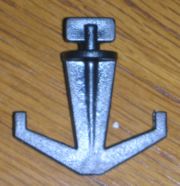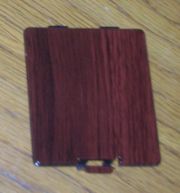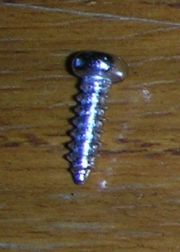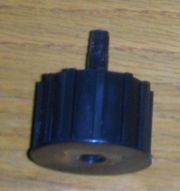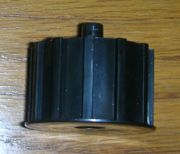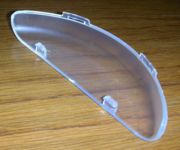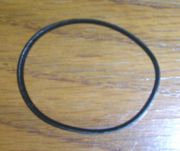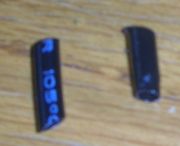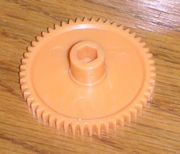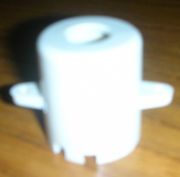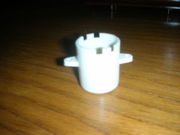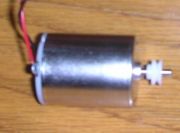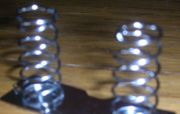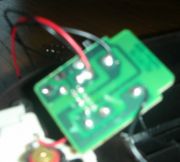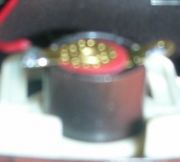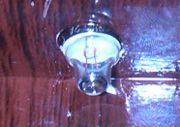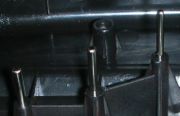Rotating tie rack
From DDL Wiki
(→Executive Summary) |
(→Other Improvements) |
||
| Line 270: | Line 270: | ||
*The quality of the wires used was very poor. The inside consisted of only 5 fibers twisted together, and as a result the wires were very thin. The soldered connections were weak and came apart when we disassembled the rack. This could also happen if the tie-rack were handled roughly. It would be better to use wires of a higher quality. | *The quality of the wires used was very poor. The inside consisted of only 5 fibers twisted together, and as a result the wires were very thin. The soldered connections were weak and came apart when we disassembled the rack. This could also happen if the tie-rack were handled roughly. It would be better to use wires of a higher quality. | ||
*Another problem was that the speed of rotation of the rack could not be varied. We concluded that the designers had chosen a speed such that it was slow enough for you to be able to see each tie as it went by. This caused problems when putting ties on the rack while it was rotating, because it rotated too fast. It was also annoying to wait for the rack to complete half a revolution to access ties that you knew were at the back of the closet. This problem could be resolved by introducing a speed controlling mechanism. The rotational speed of a DC motor is proportional to the voltage applied to it. Speed can be controlled by introducing variable battery tappings or resistors. | *Another problem was that the speed of rotation of the rack could not be varied. We concluded that the designers had chosen a speed such that it was slow enough for you to be able to see each tie as it went by. This caused problems when putting ties on the rack while it was rotating, because it rotated too fast. It was also annoying to wait for the rack to complete half a revolution to access ties that you knew were at the back of the closet. This problem could be resolved by introducing a speed controlling mechanism. The rotational speed of a DC motor is proportional to the voltage applied to it. Speed can be controlled by introducing variable battery tappings or resistors. | ||
| - | *The light bulb is not always required to be lit while rotating the rack. Having a separate circuit and switch control for the bulb would help the batteries last longer. | + | *The light bulb is not always required to be lit while rotating the rack. Having a separate circuit and switch control for the bulb would help the batteries last longer. This can be very easily done without any significant addition to the cost. |
Revision as of 14:36, 11 February 2007
Contents |
Executive Summary
The product we chose to examine was a rotating tie rack. This was designed as a space saving device. It attaches to the closet rod and it can hold up to 64 ties and 8 belts. The tie rack consists of a rotating belt, driven by a battery operated motor. The motor is enclosed by the top and bottom cover. The motor attaches to a drive train, which rotates the belt. The belt has hooks for the ties, while the belts hang in the middle of the belt. The energy input is provided by 2 sets of “C” type batteries in series, which are then connected in parallel such that the voltage input is 3 V. The rack is operated by moving the switch from its neutral position to either the left or right. The rack rotates in the corresponding direction and a light bulb lights up simultaneously.
We dissected the tie rack and analyzed the function and manufacturing processes employed in making all 26 of its components. We concluded that all the plastic parts that formed the body of the tie rack were injection molded in-house, whilst the rest of the parts were purchased. We analyzed the design for DFMA, FMEA and DFE to determine how closely the design of the tie rack followed design guidelines and to identify where there was room for improvement.
DFM (injection molding –INSERT HERE)
The various components of the tie rack were manually assembled. The design for the rack adhered to the design guidelines for DFA fairly closely. The assembly started using a large base and proceeded vertically. The assembly needed to be re-oriented only once, and all parts fit together fairly easily. The designers kept all components symmetric where possible, and made sure that the parts could not be inserted the wrong way when symmetry was not possible. One way to improve the design would be to use a single large gear instead of a gear train as this would reduce the total number of parts. In addition, it was difficult to attach the belt to the assembly. We think that increasing the height of the ledge that keeps the belt in place would make this process easier.
FMEA
DFE
In addition, we came up with other improvements not highlighted by the above analyses. The quality of the wires used was very poor and we recommend using higher quality wires, and ensuring the soldered connections are stronger than in the present design. Introducing variable speed control and having a separate switch for the light bulb to increase the life of the batteries would also improve the design.
Product Study
As part of the project, our group has selected a rotating tie rack to analyze, and attempt to apply its rotation mechanism to a rotating shoe rack
Function
This product is a space saving and organizational device. It is most likely placed in a consumers closet, and used to hang ties and belts. It can hold upto 64 ties and 8 belts. The rotating tie-rack allows the consumer to utilize the full depth of the closet that is normally wasted when using a conventional tie rack. This is because the rotating mechanism provides easy access to all ties, even those that were initially far back in the closet.
Consumer Information
Consumer Needs
- Principle needs:
- Place for storing ties
- Compact-- space saver
- Display and access ties easily
- See ties in closet when dark
- Added feature:
- Belt hanger
- Easy to fix if broken
- Affordable
Conventional Use
The product is fairly simple to use. The user begins by removing the item from its packaging. The user first inserts four C batteries into the battery compartment, and attaches the battery cover (004). The user then takes the top assembly (003) and places it over the closet rod, then placing the rest of the assembly beneath it, and fastening the two together. For some people, this is a difficult process. The top cover (011) is difficult to attach to the top assembly, and can get stuck, leaving the product partially assembled, and difficult to pull back apart. Once the product is assembled on the rod, the user must use the locking screws (002) to lock the tie rack in place on the rod. The tie rack can be attached to any rod that is smaller than the hole created when the top cover is attached to the top assembly. The locking screws can even hold a rod that is much smaller than the hole firmly in place.
Finally, once the product is assembled, it is ready to be used. Ties are hung on each hanger on the rotating belt (007), which is done easiest by letting the rack rotate while hanging a tie on each hanger. Once the ties are all hung, one can also hang belts on the belt hangers (003) hanging from the bottom of the assembly. These are difficult to acces however, because the ties are in the line of sight and the line of access. To remove a tie from the rack, one must push one of two buttons, left or right, to decide which way the belt will rotate. When the user pushes one of these buttons, a light turns on, spotlighting whichever tie is right in front of the rack. This is a good feature,since most closets tend to be dark, but the light itself does not have its own switch, meaning that the user cannot turn it off if it is undesired, which may be the case since it will drain the batteries faster.
Mechanical Functioning
The mechanical part of the system is the rotational component. The motor (018) is part of a circuit. When the switch (part 022) is in the middle position, the circuit is broken, so there is no motion of the belt (07). Upon hitting the switch, the circuit is closed, meaning the light will turn on, and the motor will begin running. The direction the motor spins is dependent on which side of the switch is pushed, because each leads to a different side of the motor. The motor turns a gear driver (014) which is connected to a gear tran of three equally sized gears(015 and 016), all of which reduce speed and increase the torque of the system. When this system reaches the final gear (016), the torque is transferred to the belt through the belt gear (008), and the belt is rotated.
Difficulties
- Assembly is difficult: top assembly and top cover are difficult to attach.
- Hanging ties is difficult: rack rotates too quickly-- must be constantly stopped while hanging ties.
- Access to belts is difficult: ties are in the way.
- Light turns on automatically when tie rack is in use, and cannot be turned off by user. This drains the battery more quickly.
- User must push the opposite button as already pushed to stop the rack. For example, if the user is pushing the right button to rotate the rack, he or she must push the left button to stop it, BUT, if the user pushes the left button too hard, the rack will begin spinning in the opposite direction.
- The speed of rotation cannot be controlled. There is no way to speed up the rotation to reach a tie that you know is right at the back of the closet faster.
Inputs and Outputs
There are many factors affecting the use and production of this product.
The inputs are:
- Energy input : 3 V (from 2 C type batteries in series. There are two sets of batteries in series, and the two sets are connected in parallel)
- Information input: User presses switch and selects direction of rotation
The outputs are:
- Energy output : Rotation of rack, light from bulb
Rotating Tie Rack Use Scenarios
The way the rack is used may vary from customer to customer. The conventional use is described in a section above, but other uses are also possible:
- Use by a man to hang ties
- Use by a woman to hang ties
- Use by a man to hang ties and belts
- Use by a woman to hang ties and belts
- Use by a man to hang belts only
- Use by a woman to hang belts only
- All of the above could be placed inside or outside of closet
Age or disability is most likely not a problem for consumers, because if hung in the proper place in closet it can be used by consumres of all heights, weight ratios, ages, and abilities.
Other Stakeholders
Aside from the consumers, there are others who are affected by the engineering and manufacturing of the product. Those individuals include, but are not limited to, the workers in the assembly line, the supervising engineers, and the people designing the manufacturing equipment.
- Common problems for the assembly workers could be:
- Assembling motor: grease on hands
- Parts not snapping together properly
- Soldering circuit board and wires could cause plastic to melt
Dissection and Analysis
The product was dissassembled to analyze each individual part of it. Each part was weighed, measured and described, and its purpose was thoroughly analyzed.
The following are the components of the assembly:
| Part # | Part Name | QTY | Function | Materials | Mass (g) | Dimensions (cm) | Manufacturing Process | Images |
|---|---|---|---|---|---|---|---|---|
| 001 | Belt hook | 4 + 4 extra | Attach to notches in middle of Belt cover to provide a place to hang belts | Plastic (1); black, hard | 2 | 3.6 x 1.355 x 0.3 | Injection molding | |
| 002 | Locking screws | 2 | Lock Top assembly into place over closet rod | - | 12 | Cap: 2.4 dia x 1.0
Screw: 0.5 dia x 3.3 | Purchased part | |
| 003 | Top assembly | 1 | Attaches tie rack to closet rod; there is an arrow to indicate the direction which it slides in | Plastic (2); black, hard, finished surface | 26 | 11.57 x 4.5 x 1.9 | Injection molding | |
| 004 | Battery cover | 1 | Protects batteries from the environment and keeps them in place | Plastic (2) | 9 | 6.9 x 6.12 x 0.2 | Injection molding | |
| 005 | Screws | 6+7+2 |
| - | 0.5 | 0.4 dia x 1.18 | Purchased part | |
| 006 | Belt cover | 1 | Holds Rotating belt, Belt gear and Belt rotator to tie rack | Plastic (2) | 45 | 29.5 x 4.6 x 0.9 | Injection molding | |
| 007 | Rotating belt | 1 |
| Plastic (3); black, flexible | 55 | 36.5 x 12.5 x 2.41 | Injection molding | |
| 008 | Belt gear | 1 |
| Plastic (4); black, hard | 14 | 4 dia x 2 x 2.05 (pin) | Injection molding | |
| 009 | Belt rotator | 1 | Holds other end of belt in place and allows for rotation | Plastic (4) | 14 | 4 dia x 2 x 1.7 (pin) | Injection molding | |
| 010 | Light cover | 1 | Protects Light bulb | Plastic (5); clear, hard | 8 | 3.1 x 10.35 x 1.4 | Injection molding | |
| 011 | Top cover | 1 | Encloses the mechanism that causes rotation | Plastic (2) | 150 | 37.95 x 13.9 x 4.8 | Injection molding | |
| 012 | Gear belt | 1 | Attaches Magnetic motor to Gear driver | - | 0.5 | 6 circ x 0.2 | Purchased part | |
| 013 | Gear cap | 4 | Holds gears and Gear driver on Pins | - | 0.1 | 0.25 ID x 0.3 OD | Purchased part | |
| 014 | Gear driver | 1 | Attaches Magnetic motor to gear train | Nylon | 2 | 2.3 dia x 1.0 | Injection molding | |
| 015 | Gear, clear | 2 | Decreases speed provided by the Magnetic motor and increases torque | Nylon 6 | 3 | 4.3 dia x 0.8 | Injection molding | |
| 016 | Gear, yellow | 1 | Decreases speed provided by the motor and increases torque | Nylon 5 | 3 | 4.3 dia x 1.2, hexagonal core | Injection molding | |
| 017 | Motor cover | 1 | Protects Magnetic motor | Plastic (6); cream, hard | 6 | 2.7 dia x 3.2 | Injection molding | |
| 018 | Magnetic motor | 1 |
| - | 136 | 2.4 dia x 3.1 | Purchased part | |
| 019 | Spring | 2 |
| - | 3 | 0.9 dia x 2.4, unloaded | Purchased part | |
| 020 | Circuit board (with wires) | 1 |
| - | 5 | 3.0 x 3.85 | Purchased part; main unit of subassembly | |
| 021 | Light bulb | 1 |
| - | 2 | 0.9 dia x 0.7 | Purchased part | |
| 022 | Switch | 1 | Allows switching the direction of rotation and activates Light bulb | Plastic (7); cream, hard | 7 | 6.8 x 3.2 x 0.8 | Injection molding | |
| 023 | Bottom cover | 1 | Encloses mechanisms for rotation | Plastic (2) | 162 | 37.95 x 13.9 x 3.3 | Injection Molding | |
| 024 | Pin | 3 | Holds gear fixed onto Bottom cover | - | 1 | 0.2 dia x 1.4 (yellow gear), x 1.85 (white gears) | Purchased part | |
| 025 | Battery end plate | 2 |
| - | 4 | 4.6 x 1.65 | Purchased part | |
| 026 | Lubricant | 1 | Facilitates movement in the gear train | - | 2 | N/A | Purchased part |
Functioning
DFMA
Design for Manufacture and Design for Assembly are aimed at producing a product that is of a high quality at a low cost in minimum time. The motivation behind DFMA is that if both considerations are taken into account while designing the product the resulting manufacturing process will be considerably more efficient. Design of Assembly refers to putting together the various parts and components that comprise the final product. It is based on the principle that significant improvement can be obtained from simplification of the product by reducing the number of separate parts and from making the parts used easy to handle and install. Design for Manufacturability refers to the actual making of the various parts and components. It is based on the fact that considerable savings can be achieved if manufacturing constraints and costs are considered when designing the product rather than after the product is designed. This includes considering factory capabilities, assembly practices, manufacturing of individual types of parts and testing of the finished product.
The process of manufacturing the tie-rack consisted of two major steps – injection molding the plastic parts, and assembling the tie-rack using the manufactured as well as the bought out components.
DFM
DFA
In order to suggest improvements in design of the product to aid assembly, we disassembled the tie rack and then attempted to recreate the stages in which it had been put together. Listed below are the various steps in the assembly process.
1.Place Bottom cover (023) wood finished side up.
2.Place Belt gear (008) in hole on Bottom cover (023). The Belt Gear (008) fits into only one of the two holes, whereas the Belt rotator (009) fits into both. Since the Belt gear (008) is assembled first, it is not possible to misassemble the Belt rotator (009).
3.Attach Rotating belt (007) to Belt gear (008) with hook side downward.
4.Place Belt rotator (009) in other hole on Bottom cover (023), such that it engages with the Rotating belt (007).
5.Attach Belt cover (006) to the assembly, so that the two projections engage with both the Belt gear (008) and the Belt rotator (009). The holder is symmetric and does not alter function depending on assembly.
6.Screw the Belt cover (006) into place. There are 6 Screws (005). This step was most likely completed by using an automated magnetic screwdriver with a maximum torque reading. The torque reading tells the operator when screw is completely assembled, and slips after maximum torque is reached so that the Screws (005) do not strip and the plastic is not stressed. We concluded this because the screws show no evidence of stripping and the plastic is not damaged in any way.
7.Flip the Bottom cover (023) over.
8.Place the Switch (022) so that the hole in the Switch (002) is aligned with the projection in the Bottom cover (023).
9.Place the electrical subassembly consisting of the Circuit board (020), Light bulb (021), both Battery end plates (025), Springs (019) and Motor (018) into Bottom cover (023). a.Put flat Battery end plate (025) into grooves on side closer to the Switch (022). The tab side should face upward. It does not fit into the groove when placed the other way, because there is an indentation that fits over the divider in the battery holder on the Bottom cover (023). b.Place Circuit board (020) into grooves with the lever side downward. Ensure that the lever engages with the switch (022) arms c.Put Battery end plate (025) with attached Springs (019) into grooves on opposite side of battery holder. d.Place the Light bulb (021) into the hole on the Bottom cover (023). It snaps into place so that the Light bulb (021) is on the finished side of the Bottom cover (023).
10.Place plastic Motor cover (017) over Magnetic motor (018).
11.Insert into the Bottom cover (023) so that the arms on the side of the plastic Motor cover (017) are aligned with the two projections (the holes should match up) N.B. Make sure that connecting tabs for the circuitry wires on the Magnetic motor (018) are located at the cutouts on the plastic Motor cover (017). The clearances on the Motor cover (017) are aligned to ensure that the wires do not interfere with projections on the Bottom cover (023).
12.Screw the Magnetic motor (018) into place using two Screws (005).
13.Attach the Gear, yellow (016) to the Bottom cover (023), ensuring that it engages with the. The hexagonal shape of the inner diameter of the Gear, yellow (016) eliminates an additional manufacturing step. The hexagonal shape allows the Gear, yellow (016) to drive the Belt gear (008). If it were circular, the two would need to be mated by an additional manufacturing process.
14.Place one Gear, clear (015) onto the Pin (025) at the lowest level (near the Gear, yellow (016)). The Gear, clear (015) should be placed projection side downward.
15.Place the second Gear, clear (015) onto the higher Pin (025).
16.Attach the Gear driver (014) onto the post nearest to the Magnetic motor (018).
17.Attach the Gear belt (012) to the Magnetic motor (018) and then stretch it so that it also attaches to the Gear driver (014).
18.Place 4 Gear caps (013) over the Pins (025).
19.Lubricate the drive train with Lubricant (026).
20.Place Top cover (011) over Bottom cover (023). The Top cover (011) has a rectangle cut out of it that goes over the battery holder, and is designed in such a way that if you try and place it the other way around (thus, covering the battery holder) it does not mate. This is done by making the projections on either side of the cover different lengths.
21.Screw the Top cover (011) in place using seven Screws (005). The Rotating belt (007) is made of a flexible material that avoids interference with a screwdriver.
22.Snap the Light cover (010) into place. First, mate the curved sides to the Top cover (011) and then snap into place by pressing down from the top.
23.Flip the entire assembly over and fit Battery cover (004) into the Top cover (011).
The assembly process is neither very labor efficient, nor very precise and so we concluded that the assembly process was carried out manually. The process of manual assembly can be divided into two distinct areas – handling and insertion and fastening. There are design guidelines that aid easy part handling and easy insertion and fastening. We found that the design of the tie-rack adhered to the DFMA guidelines for both areas fairly closely.
Design for ease of part handling
- Where it was possible, parts were symmetric about the axis of insertion. For example, the belt holder (006) was symmetric about the horizontal axis (the axis perpendicular to its axis of insertion). Increasing symmetry reduces handling time.
- Where it was not possible to have symmetrical parts, easily identifiable features were provided to indicate the correct direction of insertion. In addition, obstructions were provided to ensure that parts could not be inserted the wrong way. The belt gear (008) only fit into the hole on the bottom cover (023) that corresponded to where the yellow gear be inserted. This was done by partially filling the other hole to make the two holes different depths. The top cover (011) does not fit into the bottom cover (023) when the rectangular opening is not positioned over the battery holder. This is done by making the projections on the top cover and corresponding holes on the bottom cover different lengths
Design for ease of fastening and insertion
- The assembly begins using the bottom cover (023), which has a large mass relative to the other parts and a low center of gravity. The rest of the assembly process proceeds vertically. Parts are positioned with the aid of gravity.
- The assembly needs to be re-oriented only once (flipped over) and then right at the end to snap the battery cover (004) into place. The fixturing required to whole the assembly in place is very simple – it only needs to be clamped at two ends in order to keep it in place.
- The design eliminates the need for complex orientation and assembly movements. All parts need to be aligned only with respect to the horizontal.
- The tie-rack was also designed so that there was little or no resistance to insertion, and all parts fit together fairly easily.
- The wires are soldered onto the circuit board (020), light bulb (021), both battery end plates (025), springs (019) and motor (018) prior to attaching these components to the bottom cover (023). This serves a dual purpose. It prevents the molten metal from dripping onto the body of the tie-rack and damaging the plastic. It also makes it possible for the electric “module” of the tie-rack to be tested separately before final assembly. This is important, since the circuitry is the most sensitive part of the tie rack and requires thorough testing than the plastic components. This is evidence that the designers attempted to keep the design of the tie rack modular to the extent possible.
- The designers used common parts where possible. The use of common parts enables the purchase of larger volumes and also reduces the inventory carrying costs. Though screws (005) fasten 3 different parts of the tie-rack, the screws used are the same. The 2 clear gears (015) are also the same.
- The light cover (010) attaches to the top cover (011) by means of snap fit, an integral fastening method. This eliminates the use of threaded fasteners and so reduces assembly time.
Improvements
- One of the fundamental principles of DFMA is to minimize the number of parts. Instead of using a gear train to reduce the speed and increase the torque of the motor, it would have been easier to use a single larger gear. This would also reduce the number of pins required from 3 to 1. Each part has the possibility of being defective and also of causing and assembly error. Reducing the number of parts reduces the total cost of fabricating and assembling the product and reduces the chance of the product being defective. It also reduces levels of inventory and work-in-progress.
- Another way to reduce the part count would be to eliminate the gear train completely and use a motor with a higher torque output. However after researching the costs of various dc motors, we concluded that the cost of the gear train would probably be less than the cost of a motor with a higher torque output.
- Another DFMA guideline is to avoid the necessity for holding parts down to maintain their orientation during placement of another part. This was not followed in the procedure for attaching the rotating belt (007) to the belt gear (008) and belt rotator (009). First the belt gear was attached to the bottom cover (023). The rotating belt was placed in the groove made for it so that it engaged the belt gear. Lastly the belt rotator was put into place. This last step was somewhat difficult because the rotating belt kept slipping out of its groove. It was difficult to hold the belt in place and insert the rotator simultaneously. This was because the ledge surrounding the groove was not high enough. An easier way to attach the belt would have been to make the ledge higher, so that the belt did not slip out of its groove. The belt should be positioned in the groove first and then belt gear and belt rotator should be inserted, such that they engage with the belt.
FMEA
DFE
Other Improvements
We came up with some other design improvements in addition to the improvements we identified in the areas of DFMA and DFE and after performing FMEA.
- The quality of the wires used was very poor. The inside consisted of only 5 fibers twisted together, and as a result the wires were very thin. The soldered connections were weak and came apart when we disassembled the rack. This could also happen if the tie-rack were handled roughly. It would be better to use wires of a higher quality.
- Another problem was that the speed of rotation of the rack could not be varied. We concluded that the designers had chosen a speed such that it was slow enough for you to be able to see each tie as it went by. This caused problems when putting ties on the rack while it was rotating, because it rotated too fast. It was also annoying to wait for the rack to complete half a revolution to access ties that you knew were at the back of the closet. This problem could be resolved by introducing a speed controlling mechanism. The rotational speed of a DC motor is proportional to the voltage applied to it. Speed can be controlled by introducing variable battery tappings or resistors.
- The light bulb is not always required to be lit while rotating the rack. Having a separate circuit and switch control for the bulb would help the batteries last longer. This can be very easily done without any significant addition to the cost.
